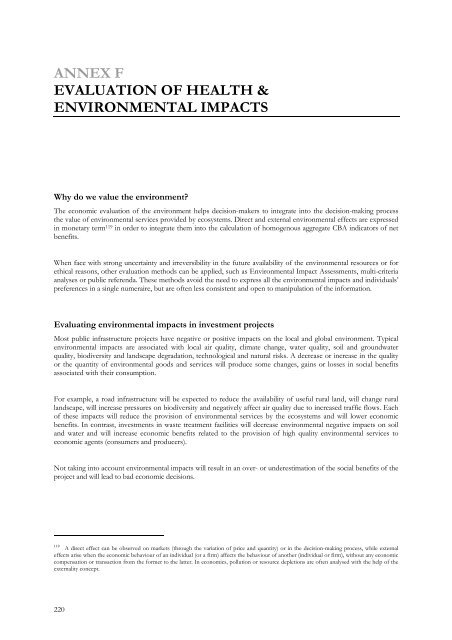Guide to COST-BENEFIT ANALYSIS of investment projects - Ramiri
Guide to COST-BENEFIT ANALYSIS of investment projects - Ramiri
Guide to COST-BENEFIT ANALYSIS of investment projects - Ramiri
You also want an ePaper? Increase the reach of your titles
YUMPU automatically turns print PDFs into web optimized ePapers that Google loves.
ANNEX FEVALUATION OF HEALTH &ENVIRONMENTAL IMPACTSWhy do we value the environment?The economic evaluation <strong>of</strong> the environment helps decision-makers <strong>to</strong> integrate in<strong>to</strong> the decision-making processthe value <strong>of</strong> environmental services provided by ecosystems. Direct and external environmental effects are expressedin monetary term 119 in order <strong>to</strong> integrate them in<strong>to</strong> the calculation <strong>of</strong> homogenous aggregate CBA indica<strong>to</strong>rs <strong>of</strong> netbenefits.When face with strong uncertainty and irreversibility in the future availability <strong>of</strong> the environmental resources or forethical reasons, other evaluation methods can be applied, such as Environmental Impact Assessments, multi-criteriaanalyses or public referenda. These methods avoid the need <strong>to</strong> express all the environmental impacts and individuals’preferences in a single numeraire, but are <strong>of</strong>ten less consistent and open <strong>to</strong> manipulation <strong>of</strong> the information.Evaluating environmental impacts in <strong>investment</strong> <strong>projects</strong>Most public infrastructure <strong>projects</strong> have negative or positive impacts on the local and global environment. Typicalenvironmental impacts are associated with local air quality, climate change, water quality, soil and groundwaterquality, biodiversity and landscape degradation, technological and natural risks. A decrease or increase in the qualityor the quantity <strong>of</strong> environmental goods and services will produce some changes, gains or losses in social benefitsassociated with their consumption.For example, a road infrastructure will be expected <strong>to</strong> reduce the availability <strong>of</strong> useful rural land, will change rurallandscape, will increase pressures on biodiversity and negatively affect air quality due <strong>to</strong> increased traffic flows. Each<strong>of</strong> these impacts will reduce the provision <strong>of</strong> environmental services by the ecosystems and will lower economicbenefits. In contrast, <strong>investment</strong>s in waste treatment facilities will decrease environmental negative impacts on soiland water and will increase economic benefits related <strong>to</strong> the provision <strong>of</strong> high quality environmental services <strong>to</strong>economic agents (consumers and producers).Not taking in<strong>to</strong> account environmental impacts will result in an over- or underestimation <strong>of</strong> the social benefits <strong>of</strong> theproject and will lead <strong>to</strong> bad economic decisions.119A direct effect can be observed on markets (through the variation <strong>of</strong> price and quantity) or in the decision-making process, while externaleffects arise when the economic behaviour <strong>of</strong> an individual (or a firm) affects the behaviour <strong>of</strong> another (individual or firm), without any economiccompensation or transaction from the former <strong>to</strong> the latter. In economics, pollution or resource depletions are <strong>of</strong>ten analysed with the help <strong>of</strong> theexternality concept.220




